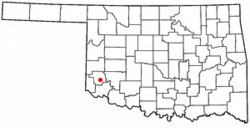Mangum, Oklahoma
| Mangum, Oklahoma | |
|---|---|
| City | |

Mangum, Oklahoma Downtown Historic District, September 28, 2014. Courtesy CrimsonEdge
|
|
 Location of Mangum, Oklahoma |
|
| Coordinates: 34°52′41″N 99°30′19″W / 34.87806°N 99.50528°WCoordinates: 34°52′41″N 99°30′19″W / 34.87806°N 99.50528°W | |
| Country | United States |
| State | Oklahoma |
| County | Greer |
| Area | |
| • Total | 1.7 sq mi (4.5 km2) |
| • Land | 1.7 sq mi (4.5 km2) |
| • Water | 0.0 sq mi (0.0 km2) |
| Elevation | 1,598 ft (487 m) |
| Population (2010) | |
| • Total | 3,010 |
| • Density | 1,800/sq mi (670/km2) |
| Time zone | Central (CST) (UTC-6) |
| • Summer (DST) | CDT (UTC-5) |
| ZIP code | 73554 |
| Area code(s) | 580 |
| FIPS code | 40-46050 |
| GNIS feature ID | 1095109 |
Mangum is a city in and county seat of Greer County, Oklahoma, United States. The population was 3,010 at the 2010 census. It was originally part of Old Greer County in the Texas panhandle. The community was named for A. S. Mangum, who owned the land on which the town was founded in 1882. It became part of Oklahoma Territory in 1896, and thus part of the state of Oklahoma on November 16, 1907.
Beginning in 1876, the nearby Western Trail was used to drive cattle north from Texas to market. The community of Mangum began in 1882 when Henry Clay Sweet established it on land granted to A. S. Mangum by the state of Texas. The Mangum post office was established April 15, 1886. This part of Texas (old Greer County) was given to Oklahoma in 1896. During Mangum's early days, the community's economy largely depended on very large cattle ranches owned or leased by land companies such as the Day Land and Cattle Company of Texas and the Franklyn Land and Cattle Company, an English syndicate. During those very early days, the local cowboys called Magnum "Tin City" because so many tin cans were unrolled and nailed over the wooden planks that served as sidewalks.
The Kiser Salt Works, named for owner Ben Kiser and located on the Elm Fork of the Red River was one of the earliest production operations in what would become western Oklahoma.
Other early businesses in or around Magnum included the Oklahoma Granite Company, which opened in 1904, the Mangum Star newspaper, first published in 1887, and the Mangum Brick Plant, established in 1903 by D. J. Doyle. The newspaper still publishes in the 21st Century. The brick plant, now owned by Jewett Scott, also still operates and has greatly expanded production.
By statehood, Mangum had a population of 2,672. It had two school buildings, an opera house and a county courthouse, listed in the National Register of Historical Places, NR 85000682. By 1930, the population had expanded to 4,806 (the highest recorded in the U.S. census. Agriculture had largely displaced the old cattle ranches, so the city could also boast of seven cotton gins, one cotton oil mill, one cotton compress, and one flour mill.
The Chicago, Rock Island and Pacific Railroad (aka Rock Island or CRI&P) built a line from Chickasha, Oklahoma to Mangum in 1900. The Wichita Falls and Northwestern Railway, acquired by the Missouri, Kansas and Texas Railway (also known as M-K-T or Katy) in 1911, operated its own line through Mangum by 1910.
...
Wikipedia
